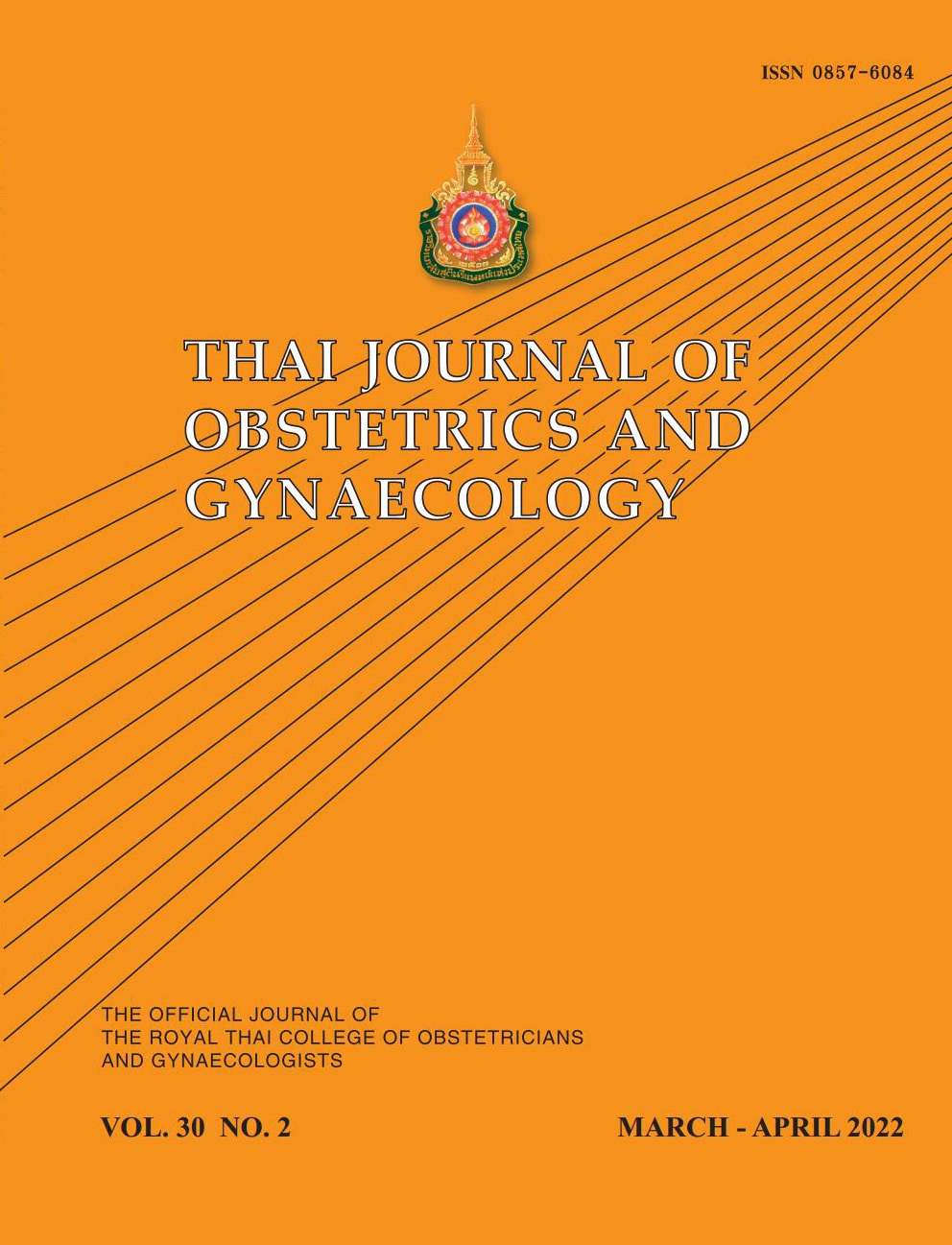Lidocaine Prilocaine Cream in Conjunction with Paracervical Block versus Placebo with Paracervical Block for Pain Relief during Fractional Curettage
Main Article Content
Abstract
Objectives: To study the efficacy of lidocaine prilocaine cream apply at cervix in conjunction with paracervical block versus placebo with paracervical block for pain reduction during fractional curettage.
Materials and Methods: One hundred and six women who underwent fractional curettage at Khon Kaen Hospital were enrolled in a randomized, double-blinded, placebo-controlled trial. The participants were randomly allocated into two groups, received lidocaine prilocaine cream plus paracervical block applied onto cervix (n = 53) versus placebo cream plus paracervical block (n = 53) before performing fractional curettage. Pain score was measured at tenaculum placement, during procedure, immediately after and 30 minutes after the procedure, using a 10 centimeters visual analog scale (VAS). The adverse events and additional analgesia were also recorded.
Results: Baseline characteristics were similar between groups. Mean pain score during fractional curettage in lidocaine prilocaine cream plus paracervical block was significantly lower than placebo cream plus paracervical block (2.80 ± 0.29, 95% confidence interval (CI) 2.21-3.38 vs. 5.34 ± 0.39, 95%CI 4.55-6.13, p < 0.001). Adverse events such as lightheadedness, palpitation and tinnitus were found without statistically significant difference between groups. None of the participants requested an additional analgesia.
Conclusion: Lidocaine prilocaine cream in conjunction with paracervical block had better pain relief during fractional curettage than in control group without serious adverse events.
Article Details

This work is licensed under a Creative Commons Attribution-NonCommercial-NoDerivatives 4.0 International License.
References
Api O, Ergen B, Api M, Ugurel V, Emeksiz MB, Unal O. Comparison of oral nonsteroidal analgesic and intrauterine local anesthetic for pain relief in uterine fractional curettage: a randomized, double-blind, placebo-controlled trial. Am J Obstet Gynecol 2010;203:28.e1-7.
Arora A, Shukla A, Saha SC. Effectiveness of intrauterine lignocaine in addition to paracervical block for pain relief during dilatation and curettage, and fractional curettage. J Obstet Gynaecol India 2016;66:174-9.
Arnau B, Jovell E, Redón S, Canals M, Mir V, Jiménez E. Lidocaine‐prilocaine (EMLA®) cream as analgesia in hysteroscopy practice: a prospective, randomized, non‐blinded, controlled study. Acta Obstet Gynecol Scand 2013;92:978-81.
Tangsiriwatthana T, Sangkomkamhang US, Lumbiganon P, Laopaiboon M. Paracervical local anaesthesia for cervical dilatation and uterine intervention. Cochrane Database Syst Rev 2013:9:CD005056.
Thongrong P, Jarruwale P, Panichkul P. Effectiveness of paracervical block versus intravenous morphine during uterine curettage: a randomized controlled trial. J Med Assoc Thai 2011;94:403-7.
Ljunghall K, Lillieborg S. Local anaesthesia with a lidocaine/prilocaine cream (EMLA) for cautery of condylomata acuminata on the vulval mucosa. The effect of timing of application of the cream. Acta Derm Venereol 1989;69:362-5.
Van der Burght M, Schønemann N, Laursen J, Arendt-Nielsen L, Bjerring P. Duration of analgesia following application of eutectic mixture of local anaesthetics (EMLA) on genital mucosa. Acta Derm Venereol 1993;73:456.
Liberty G, Gal M, Halevy-Shalem T, Michaelson-Cohen R, Galoyan N, Hyman J, et al. Lidocaine–Prilocaine (EMLA) cream as analgesia for hysterosalpingography: a prospective, randomized, controlled, double blinded study. Hum Reprod 2007;22:1335-9.
Zilbert A. Topical anesthesia for minor gynecological procedures: a review. Obstet Gynecol Surv 2002;57: 171-8.
Zullo F, Pellicano M, Stigliano C, Di CC, Fabrizio A, Nappi C. Topical anesthesia for office hysteroscopy. A prospective, randomized study comparing two modalities. J Reprod Med 1999;44:865-9.
Tavakolian S, Doulabi MA, Baghban AA, Mortazavi A, Ghorbani M. Lidocaine-prilocaine cream as analgesia for IUD insertion: a prospective, randomized, controlled, triple blinded study. Glob J Health Sci 2015;7:399.
Zilbert A. Topical anesthesia for minor gynecological procedures: a review. Obstet Gynecol Surv 2002;57:171-8.


